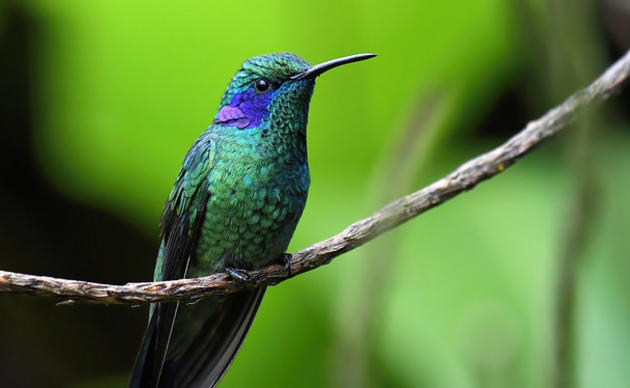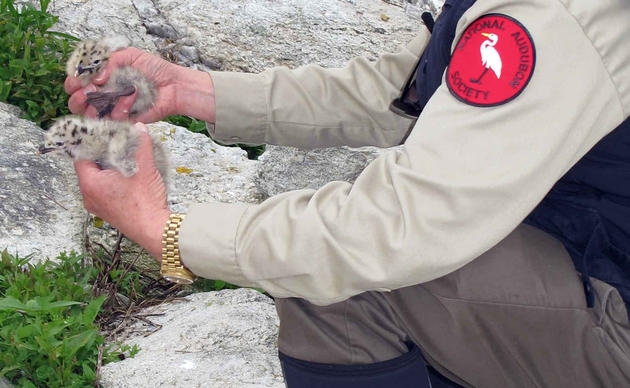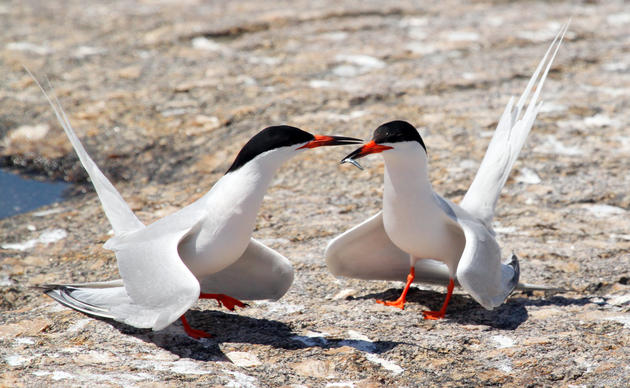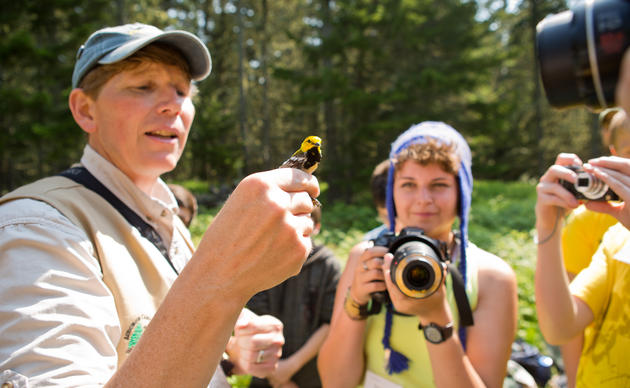SHAKEDOWN CRUISE is an hour and a half trip on the waters surrounding Hog Island. The cruise passes through the Hockomock Channel into Greenland Cove and through rich lobstering areas. This introductory boat trip proceeds up the wild shore of Hog Island before returning through the channel, visiting the remains of the Cora F. Cressy, a locally built, five-masted, turn of the century schooner.
Notable birds: Bald Eagle; Osprey; Double-Crested Cormorant; Great Blue Heron; Common Eider; scoters; and Laughing, Herring, and Great Black-backed Gulls.
What to wear and bring: Binoculars, field guide, camera, sunhat, sunscreen, sweater, and a windbreaker/raincoat (depending on weather).
KNOW YOUR ‘BINS’ AND GUIDES WORKSHOP provides information for both beginning and experienced birders about selection and use of binoculars, spotting scopes and field guides. The class includes discussion of note-taking techniques, along with an opportunity to try out a wide variety of binoculars by sharing optics and other birding gear within the class. The session covers how to focus quickly, spot birds and communicate to others how to find the birds which you see.
What to wear and bring: Binoculars, field guide, and a notebook.
HIKE HOG ISLAND and experience one of the best examples of spruce-fir forest on a Maine coastal island. Most of our 333-acre island has mature forest and younger spruce forest formed after hurricane blowdowns. The forest is interrupted only by fragrant fields of hay-scented fern and the occasional sphagnum bog. On this trip, we will offer various length hikes to explore the more remote parts of the island. In addition to its varied birdlife, Hog Island has a rich human history, including the summer cottages of Mabel Loomis Todd, editor of Emily Dickinson’s poetry, and Millicent Todd Bingham, Mabel’s daughter who donated Hog Island to Audubon.
Notable birds: Osprey; Winter Wren; Hermit Thrush; White-throated Sparrow; Blackburnian, Parula, Magnolia, Black and White, and Black-throated Green Warblers; Golden-crowned Kinglet; Red-breasted Nuthatch.
What to bring: Binoculars, field guide, insect repellent, hiking boots, day pack, and a water bottle.
MUSCONGUS BAY ISLANDS CRUISE begins by travelling down the east shore of Hog Island, past Wreck Island and circles Eastern Egg Rock, a restored puffin and tern nesting island located 8 miles south of Hog Island. If weather permits, the island supervisor will row out and come on board to tell us the latest seabird news. The trip will continue past Franklin Island Light, an automated light house that was originally commissioned by Thomas Jefferson in 1805. The island is presently managed as a National Wildlife Refuge. This trip sometimes the trip includes a landing at Harbor Island, a 100-acre private sanctuary. The northern seven acres of the island are owned by National Audubon as the Duryea Morton Wildlife Sanctuary in honor of Duryea Morton, former Director of the Audubon Camp in Maine.
Notable birds: Bald Eagle; Osprey; loons; eider; Atlantic Puffin; Black Guillemot; Laughing Gull; Arctic; Common, and Roseate Terns.
Additional possible sightings include: Razorbill; Wilson’s Storm-Petrel; Northern Gannet; and Shearwaters. Black-throated Green, and Parula Warblers; American Redstart; Swainson’s Thrush.
What to bring: Binoculars, field guide, camera, notebook, sunhat, sunscreen, wind breaker/raincoat, and hiking boots or sneakers.
WRECK ISLAND is a 15 acre state-owned wildlife sanctuary located 4 miles south of Hog Island. We will visit Wreck Island and land on its north shore for the rare opportunity of close-up views of Great Blue Herons. About 50 pairs of Great Blue Herons nest in the interior of the island with occasional Black-crowned Night-herons. A walk through the edge of the colony will show the dramatic impact of the birds on the island vegetation. We will also look for nesting gulls and eiders. The island is home to several pairs of Ospreys and a pair of Bald Eagles.
Notable birds: Great Blue Heron; Bald Eagle; Osprey; Common Eider; Herring Gull.
What to bring: This is usually a wet landing, which includes walking over slippery seaweed-covered rocks. Wear boots or water shoes with a good grip. Also bring a windbreaker/raincoat, sunhat, sunscreen, notebook, binoculars, and a camera.
WESKEAG MARSH is a tidal saltmarsh located near Thomaston, Maine and one of the great birding hot spots for mid-coast Maine. Camp vans travel 45 minutes to this state wildlife preserve with a stop along the way to look for American Bittern and Sora and Virginia Rail in a freshwater marsh outside of scenic Waldoboro. Weskeag Marsh is an excellent habitat for watching shorebirds, waterfowl, wading birds, and grassland birds.
Notable Birds: Nelson’s Sharp-tailed amd Savannah Sparrows; Snowy Egrets; Glossy Ibis; Merlin; Peregrine; shorebirds, and waterfowl.
What to bring: Sunhat, sunscreen, windbreaker. Spotting scope, binoculars, field guide, and a camera.
How you can help, right now
Instructors and Staff
We have some of the most brilliant ornithologists, authors, artists, and educators as part of our staff.
Camp Sessions
Learn more about our birding and nature camp sessions for adults, teens, and families.




